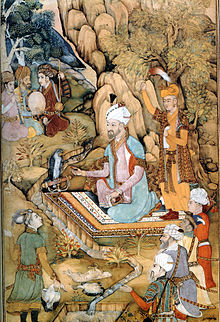Kaftan


A kaftan (from Persian خفتان – ġaftān) is a man's coat usually reaching to the ankles with long sleeves, and which buttons down the front. It can be made of wool, cashmere, silk, or cotton. It is often worn with a sash.
The kaftans worn by the Ottoman sultans constitute one of the most splendid collections of Topkapı Palace in Istanbul. Some of them were so precious that they were given as rewards to important dignitaries and victorious generals during elaborate religious festivals (see the "khalat" article).
By the nineteenth century, kaftans[1] were often embroidered on the front and on the sleeves. Like so many garments during Ottoman rule, there was a strict hierarchical order in the colours, patterns, ribbons and buttons, which were chosen according to the rank of the person to whom they were presented.
From the 14th century through 17th centuries large patterns were used. The decorative patterns on the fabrics became both smaller and brighter in the late 16th and in the 17th centuries. By the second half of the 17th century, the most precious fabrics were those with 'yollu': vertical stripes with various embroideries and small patterns, the so-called "Selimiye" fabrics.

Most fabrics manufactured in Turkey were made in Istanbul and Bursa, but some textiles came from as far as Venice, Genoa, Persia, India and even China. Each had very specific characteristics and was named accordingly. Examples include velvet, aba, bürümcük (a type of crepe with a silk warp and cotton weft), canfes, çatma (a heavy silk brocade), gezi, diba (Persian ديبا), hatayi, kutnu, kemha, seraser (Persian سراسر) (brocade fabric with silk warp and gold or silver metallic thread weft[2]), serenk, zerbaft (Persian زربفت), tafta (Persian تافته). The most often used colours were indigo blue, kermes red, violet, pişmis ayva or "cooked quince", and weld yellow.
The Topkapı Museum, Istanbul, possesses a large collection of Ottoman kaftans and textiles.[3] Mughal Kaftans were known for their complex embroidery and its reliance upon the usage of beads and even gemstones, some Mughal robes even contained verses from the Quran.[4]
Fashion designer Tom Ford designed velvet Kaftans for the fashion house Gucci in the 1990s, which was referred to as "hippie chic" by those in fashion circles.
Russian kaftan
In Russia the word "kaftan" is used for another type of clothing: a kind of a man's long suit with tight sleeves. By 19th century Russian kaftans were the most widely spread type of outer clothing among peasants and merchants. Currently they are used as a ritual religious clothing by the most conservative sect of Old Believers.
Moroccan kaftan
In Morocco kaftans are only worn by women, see Takshita, which are substantially different from their Turkish counterpart. It can be dressy casual to extremely formal depending on the materials used. They can be worn at dinner parties, baby showers, engagement parties and weddings.
Batik kaftan
In South East Asia, batik kaftans are produced for cool floaty feeling in hot sweltering heat of the tropical weather. While batik is very acid fast, numerous kind of fabrics are used ranging from silk to viscose. Florals and abstract designs heavily influence the kaftans from this region.[5]
West African kaftans
In West Africa, a kaftan is a pullover robe. In French, this robe is called a boubou. Kaftans are worn by both men and women.[6] In West Africa, the female robe is called a kaftan or a boubou, and the male robe is the Senegalese kaftan.
See also
References
- ^ IsmailAcar.com – Kaftans[dead link]
- ^ http://www.sadberkhanimmuzesi.org.tr/default.asp?page=koleksiyon&kl=detay&tkid=9&oid=26&aid=65&id=75&hl=en Sadberk Hanim Museum
- ^ IstanbulNet @ www.istanbulnet.com.tr. "Topkapi Museum: collection of Turkish textiles and kaftans". Exploreturkey.com. Retrieved 2009-10-09.
- ^ http://books.google.com/books?id=N7sewQQzOHUC&dq=mughal+empire&q=aurangzeb#v=snippet&q=cannonballs&f=false
- ^ "Batik Art Kaftan".
- ^ "Native Robes".
